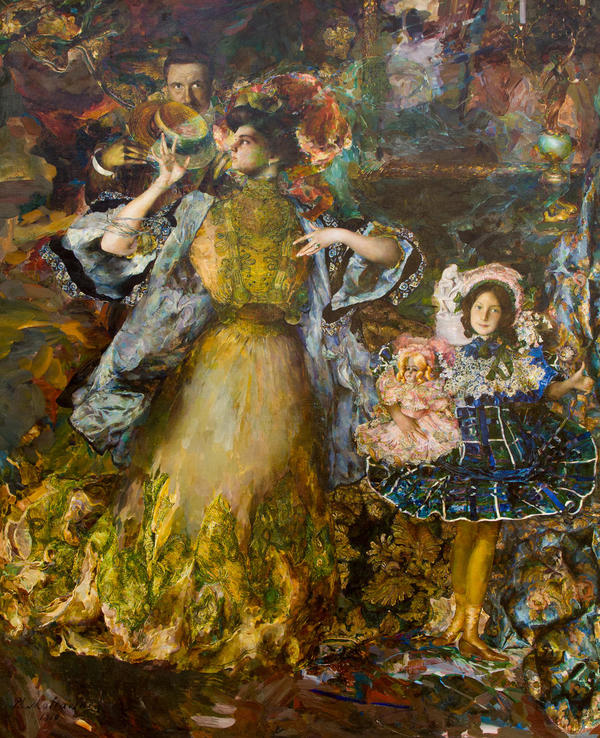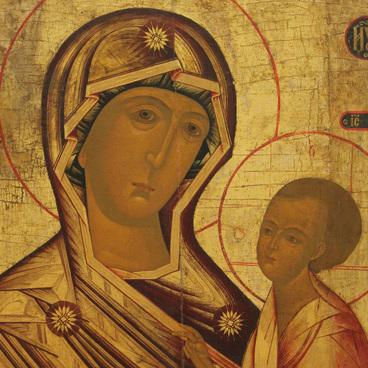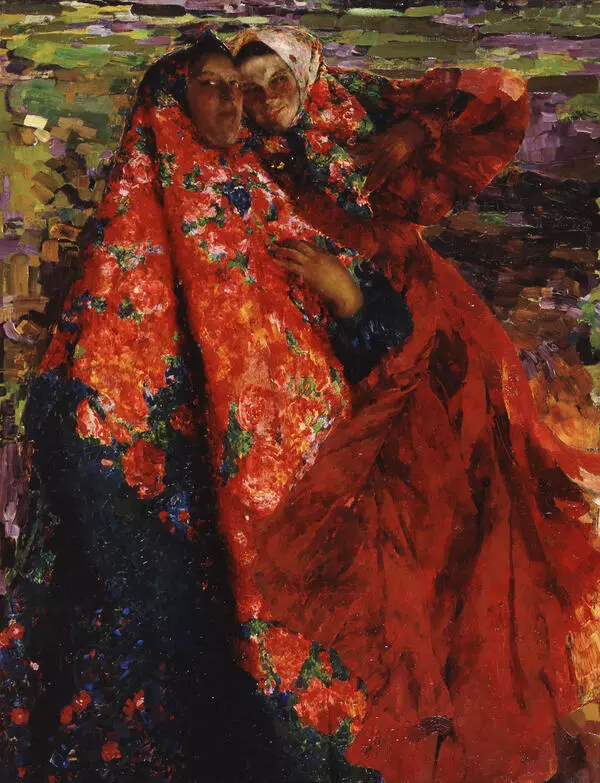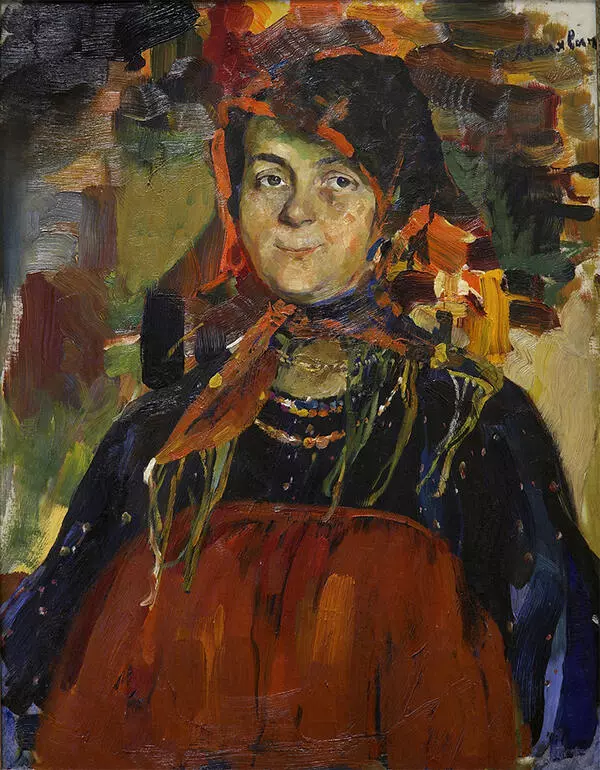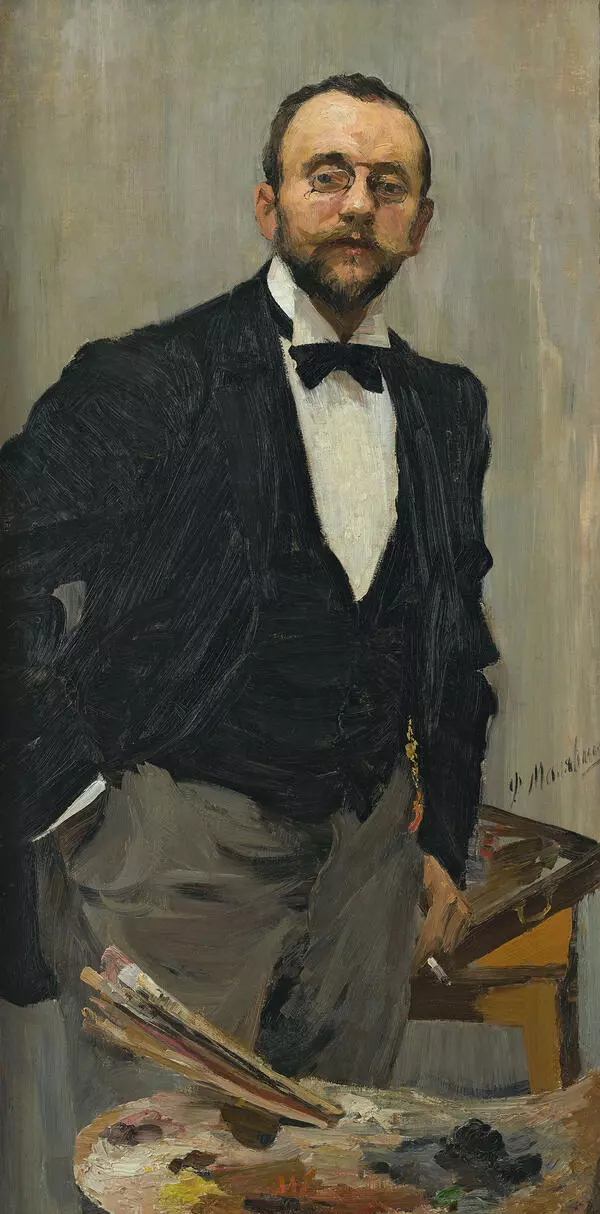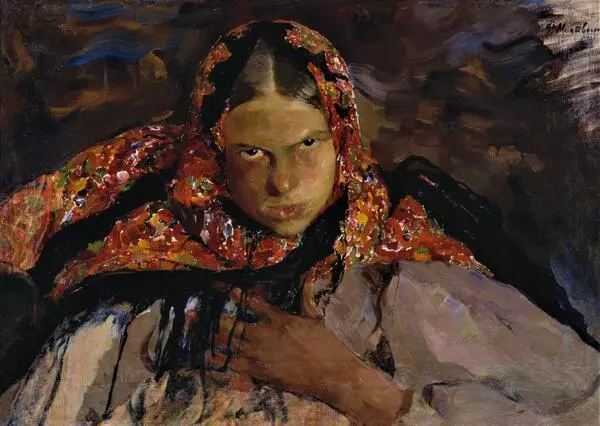Russian portrait painter Philip Malyavin did his Self-Portrait with Wife and Daughter in 1910 as suggested by the signature in Russian made in red paint on the front of the painting at the left edge. Below it the painter signed in black: Ph. Malyavine. 1910.
The family portrait is done in a modernist style where the peasantry Malyavin we know, with his characteristic female portraits, becomes the chic Malyavin. For a village-born artist who grew into a wealthy member of the Art Academy and a painter whose art was exhibited and popular both in Russia and elsewhere, the Self-Portrait with Wife and Daughter became a mark of self-assertion in the society and in art.
It is for that reason that Malyavin produced it on a huge canvas, using decorative painting which imitated a precious mosaic and sparkling brocade. However, the opulence of the images and the lively rhythm of the canvas fail to remove the sense of melancholy and apprehension, which is particularly keen in the face of the man.
Featured in the centre of the composition is a young woman, Malyavin’s wife: Natalia Novak-Savich, a pupil of Ilya Repin and a non-matriculating student of the Art Academy. She is wearing an ochre-green sumptuous festive dress and a dark overcoat with broad sleeves, and she is moving to pull up the veil pinned to her hat. Below to her right is the painter’s daughter, Zoie, in a short blue-green dress and a lacey hat, holding a doll. Malyavin painted himself behind his wife, his face partly concealed behind a straw hat, but he is looking straight at the viewer. In contrast to carefully painted faces, the background is done in broad, sweeping strokes.
Philip Malyavin painted his Self-Portrait in his Ryazan country estate. By that time, he was a renowned master, academician and a fashionable portrait painter in St Petersburg’s high society. In the beginning of 1911, the artist submitted his work to the VIIIth exhibition of the Union of Russian Artists, but the portrait was not liked. He stopped displaying his art from then until 1916.
When Malyavin emigrated in 1922 he took this painting with him, first to Riga and then to France. For a long time, nobody knew what happened to the self-portrait. It resurfaced in the late 1940s – early 1950s, when, following the painter’s death, his daughter, Zoie Malyavina, sold it at the Sotheby’s auction. The Self-Portrait stayed in the family of its buyer, a businessman, through the late 1990s, when it was sold on by his children and ended up in the collection of the Khanty-Mansiysk Art Museum. It has rediscovered its public again, three quarters of a century later.
The family portrait is done in a modernist style where the peasantry Malyavin we know, with his characteristic female portraits, becomes the chic Malyavin. For a village-born artist who grew into a wealthy member of the Art Academy and a painter whose art was exhibited and popular both in Russia and elsewhere, the Self-Portrait with Wife and Daughter became a mark of self-assertion in the society and in art.
It is for that reason that Malyavin produced it on a huge canvas, using decorative painting which imitated a precious mosaic and sparkling brocade. However, the opulence of the images and the lively rhythm of the canvas fail to remove the sense of melancholy and apprehension, which is particularly keen in the face of the man.
Featured in the centre of the composition is a young woman, Malyavin’s wife: Natalia Novak-Savich, a pupil of Ilya Repin and a non-matriculating student of the Art Academy. She is wearing an ochre-green sumptuous festive dress and a dark overcoat with broad sleeves, and she is moving to pull up the veil pinned to her hat. Below to her right is the painter’s daughter, Zoie, in a short blue-green dress and a lacey hat, holding a doll. Malyavin painted himself behind his wife, his face partly concealed behind a straw hat, but he is looking straight at the viewer. In contrast to carefully painted faces, the background is done in broad, sweeping strokes.
Philip Malyavin painted his Self-Portrait in his Ryazan country estate. By that time, he was a renowned master, academician and a fashionable portrait painter in St Petersburg’s high society. In the beginning of 1911, the artist submitted his work to the VIIIth exhibition of the Union of Russian Artists, but the portrait was not liked. He stopped displaying his art from then until 1916.
When Malyavin emigrated in 1922 he took this painting with him, first to Riga and then to France. For a long time, nobody knew what happened to the self-portrait. It resurfaced in the late 1940s – early 1950s, when, following the painter’s death, his daughter, Zoie Malyavina, sold it at the Sotheby’s auction. The Self-Portrait stayed in the family of its buyer, a businessman, through the late 1990s, when it was sold on by his children and ended up in the collection of the Khanty-Mansiysk Art Museum. It has rediscovered its public again, three quarters of a century later.

